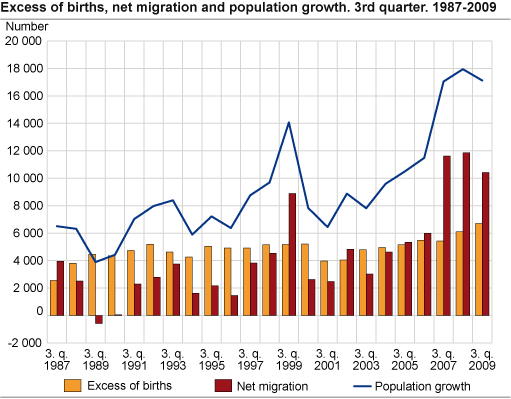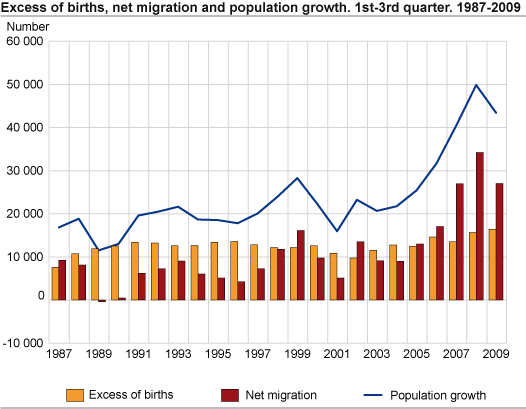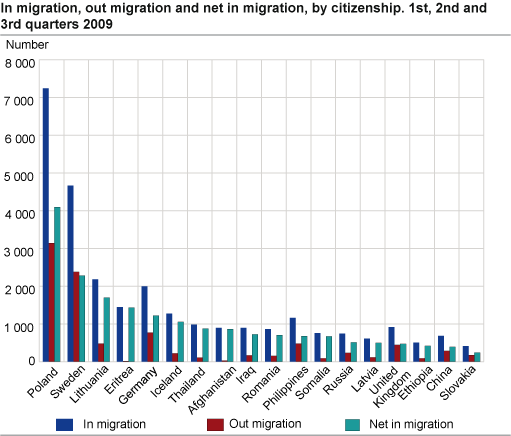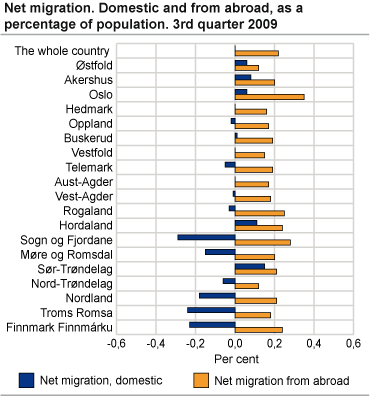Content
Published:
This is an archived release.
The high population increase continues
In the third quarter of 2009, Norway’s population increased by 17 100. Slightly more than 60 per cent of the growth resulted from inward migration, but the birth surplus contributed more than last year - 39 per cent. The number of children born was the highest since the mid 70s.
The population reached 4 842 700 on 1 October. The population increase of 17 100 is the second highest ever registered in a third quarter. A total of 18 750 persons migrated to Norway and 8 350 left during this period, resulting in a net inward migration of 10 400. In the third quarter last year, the net inward migration was 11 900, whereas in previous years it was no more than 6 000 at its peak.
Fewer Polish citizens migrated to Norway
A total of 15 500 immigrants without Norwegian citizenship arrived in the third quarter; 800 fewer than last year.
With regard to 2009 so far, Polish citizens continue to be the largest group, but their number decreased from last year’s 11 500 to 7 200 this year. Whereas 1 400 Polish citizens left Norway during the first nine months of 2008, 3 100 left this year, resulting in the net inward migration decreasing by 60 per cent, from 10 100 in 2008 to 4 100 this year. The net inward migration of German citizens also decreased similarly, whereas the figures for the Swedish citizens remained unchanged from last year.
Icelandic citizens returning “home”
Icelandic citizens now constitute the sixth largest group if immigrants. In the first three quarters of 2008, only 200 Icelandic citizens migrated to Norway, but this year, the figure was 1 300. This constitutes 0.4 per cent of Iceland’s population, and the impact would be the same in Norway if 19 000 Norwegian citizens had left for another country.
The immigration from Eritrea also increased markedly, from 400 during the period January-September last year to 1 400 so far this year. From its neighbouring countries - Ethiopia and Somalia - the figures remained unchanged.
Many children born
A total of 16 400 children were born in the third quarter; 400 more than last year. Not since the mid-1970s have more children been born in a single quarter. A total of 9 700 persons died; 200 fewer than in the corresponding period last year. The birth surplus thus reached 6 700; 10 per cent higher than in the same quarter in 2008, which again was 12 per cent higher than in 2007. Oslo had the highest birth surplus (1 700), and only one county saw a birth deficit, Hedmark (35).
In the first three quarters of 2009, 47 400 children were born, whereas the number of deaths was 31 000. This resulted in a birth surplus of 16 400; 800 more than the corresponding period of 2008.
Largest population growth in central areas
Thirty-seven per cent of the population growth took place in Akershus and Oslo, and 26 per cent in Rogaland and Hordaland. Unlike last year, none of the counties experienced a population deficit.
Eleven counties experienced domestic migration loss in the third quarter
All counties had an inward migration surplus from abroad, with Oslo having the highest figure
(2 000). Eight counties had a domestic migration surplus, with Hordaland having the highest figure (550). Eleven counties had a domestic migration deficit, with Nordland having the highest (400).
In the first three quarters of 2009, Oslo had the highest inward migration surplus from abroad (4 000), but in the corresponding period last year, the figure was 8 600. Ten counties had a domestic migration surplus, with Akershus having the highest figure (1 600). Nine counties had a domestic migration deficit, with Nordland having the highest (900).
Population growth in 293 municipalities in the first three quarters of 2009
The population increased in 293 municipalities in the first three quarters of 2009, and decreased in 133 municipalities. If it had not been for immigration, 184 municipalities would have experienced an increase and 240 a decrease. As has been the case in recent years, centralised municipalities experienced a population increase, while less centralised areas were more likely to see a migration loss as well as a birth deficit.
Birth deficit in many inland municipalities
A total of 235 municipalities saw a birth surplus, whereas 183 experienced a birth deficit. Of the 10 municipalities with the largest birth deficit, eight were situated in the inland county Hedmark. Birth deficit is a larger problem, however, in many coastal municipalities with few inhabitants.
| Total migration gain (312 in total) | Domestic migration gain (153 in total) | Migration gain from abroad (406 in total) | |||||||||||||||||||||||||||||||||||||
|---|---|---|---|---|---|---|---|---|---|---|---|---|---|---|---|---|---|---|---|---|---|---|---|---|---|---|---|---|---|---|---|---|---|---|---|---|---|---|---|
| 1 | 0301 Oslo | 4 351 | 1201 Bergen | 859 | 0301 Oslo | 4 017 | |||||||||||||||||||||||||||||||||
| 2 | 1201 Bergen | 2 208 | 0235 Ullensaker | 353 | 1201 Bergen | 1 349 | |||||||||||||||||||||||||||||||||
| 3 | 1601 Trondheim | 1 223 | 0301 Oslo | 334 | 1103 Stavanger | 1 166 | |||||||||||||||||||||||||||||||||
| 4 | 1103 Stavanger | 932 | 0231 Skedsmo | 241 | 1601 Trondheim | 1 023 | |||||||||||||||||||||||||||||||||
| 5 | 0219 Bærum | 659 | 0106 Fredrikstad | 239 | 1102 Sandnes | 555 | |||||||||||||||||||||||||||||||||
| 6 | 0602 Drammen | 630 | 0219 Bærum | 214 | 1001 Kristiansand | 450 | |||||||||||||||||||||||||||||||||
| 7 | 1001 Kristiansand | 564 | 0602 Drammen | 211 | 0219 Bærum | 445 | |||||||||||||||||||||||||||||||||
| 8 | 0106 Fredrikstad | 525 | 1124 Sola | 210 | 0602 Drammen | 419 | |||||||||||||||||||||||||||||||||
| 9 | 0235 Ullensaker | 494 | 1601 Trondheim | 200 | 1504 ålesund | 302 | |||||||||||||||||||||||||||||||||
| 10 | 0231 Skedsmo | 489 | 0101 Halden | 185 | 0106 Fredrikstad | 286 | |||||||||||||||||||||||||||||||||
| Total migration loss (117 in total) | Domestic migration loss (271 in total) | Migration loss to abroad (15 in total) | |||||||||||||||||||||||||||||||||||||
| 1 | 1416 Høyanger | -70 | 1103 Stavanger | -234 | 1441 Selje | -4 | |||||||||||||||||||||||||||||||||
| 2 | 1922 Bardu | -69 | 1102 Sandnes | -143 | 1725 Namdalseid | -3 | |||||||||||||||||||||||||||||||||
| 3 | 1511 Vanylven | -59 | 1901 Harstad | -123 | 1915 Bjarkøy | -3 | |||||||||||||||||||||||||||||||||
| 4 | 1860 Vestvågøy | -57 | 1922 Bardu | -123 | 1657 Skaun | -3 | |||||||||||||||||||||||||||||||||
| 5 | 2011 Guovdageaidnu Kautokeino | -56 | 1401 Flora | -114 | 0631 Flesberg | -3 | |||||||||||||||||||||||||||||||||
| 6 | 1135 Sauda | -40 | 1003 Farsund | -103 | 0941 Bykle | -3 | |||||||||||||||||||||||||||||||||
| 7 | 2018 Måsøy | -37 | 1221 Stord | -101 | 0121 Rømskog | -2 | |||||||||||||||||||||||||||||||||
| 8 | 1441 Selje | -36 | 1703 Namsos | -97 | 1021 Marnardal | -2 | |||||||||||||||||||||||||||||||||
| 9 | 0834 Vinje | -35 | 1416 Høyanger | -97 | Seven municipalities | -1 | |||||||||||||||||||||||||||||||||
| 10 | 2025 Deatnu Tana | -35 | 1805 Narvik | -96 | |||||||||||||||||||||||||||||||||||
| Excess of births (235 in total) | Excess of births in relation to population/1 000 (235 in total) (Norway = 3.4) | Population growth (293 in total) | Population growth in relation to population/1 000 (293 in total) (Norway = 9.0) | ||||||||||||||||||||||||||||||||||||
|---|---|---|---|---|---|---|---|---|---|---|---|---|---|---|---|---|---|---|---|---|---|---|---|---|---|---|---|---|---|---|---|---|---|---|---|---|---|---|---|
| 1 | 0301 Oslo | 4 466 | 1120 Klepp | 11.0 | 0301 Oslo | 8 817 | 1264 Austrheim | 51.2 | |||||||||||||||||||||||||||||||
| 2 | 1201 Bergen | 1 231 | 1119 Hå | 10.3 | 1201 Bergen | 3 439 | 1835 Træna | 48.4 | |||||||||||||||||||||||||||||||
| 3 | 1601 Trondheim | 1 011 | 1247 Askøy | 9.6 | 1601 Trondheim | 2 234 | 0234 Gjerdrum | 35.0 | |||||||||||||||||||||||||||||||
| 4 | 1103 Stavanger | 776 | 1432 Førde | 9.5 | 1103 Stavanger | 1 708 | 1233 Ulvik | 32.0 | |||||||||||||||||||||||||||||||
| 5 | 1102 Sandnes | 451 | 2011 Guovdageaidnu Kautokeino | 9.4 | 0219 Bærum | 1 083 | 0618 Hemsedal | 31.1 | |||||||||||||||||||||||||||||||
| 6 | 1902 Tromsø | 428 | 0234 Gjerdrum | 9.3 | 1001 Kristiansand | 942 | 1245 Sund | 28.8 | |||||||||||||||||||||||||||||||
| 7 | 0219 Bærum | 424 | 1827 Dønna | 9.1 | 1102 Sandnes | 863 | 1516 Ulstein | 28.4 | |||||||||||||||||||||||||||||||
| 8 | 1001 Kristiansand | 378 | 1142 Rennesøy | 9.0 | 0602 Drammen | 831 | 1120 Klepp | 27.6 | |||||||||||||||||||||||||||||||
| 9 | 1804 Bodø | 318 | 1245 Sund | 8.8 | 0231 Skedsmo | 710 | 1142 Rennesøy | 27.5 | |||||||||||||||||||||||||||||||
| 10 | 1247 Askøy | 235 | 1124 Sola and 1252 Modalen | 8.5 | 1804 Bodø | 689 | 1124 Sola | 27.4 | |||||||||||||||||||||||||||||||
| Birth deficit (183 in total) | Birth deficit in relation to population / 1000 (183 in total) | Population decrease (133 in total) | Population decrease in relation to population / 1 000 (133 in total) | ||||||||||||||||||||||||||||||||||||
| 1 | 0402 Kongsvinger | -54 | 1917 Ibestad | -16.0 | 1511 Vanylven | -77 | 2018 Måsøy | -37.4 | |||||||||||||||||||||||||||||||
| 2 | 0425 åsnes | -44 | 1867 Bø | -15.2 | 1416 Høyanger | -76 | 1144 Kvitsøy | -36.9 | |||||||||||||||||||||||||||||||
| 3 | 1867 Bø | -43 | 0432 Rendalen | -14.9 | 1867 Bø | -71 | 1818 Herøy | -28.5 | |||||||||||||||||||||||||||||||
| 4 | 1228 Odda | -41 | 1613 Snillfjord | -13.2 | 2018 Måsøy | -49 | 1915 Bjarkøy | -27.8 | |||||||||||||||||||||||||||||||
| 5 | 0417 Stange | -38 | 1227 Jondal | -11.7 | 1860 Vestvågøy | -49 | 1859 Flakstad | -27.5 | |||||||||||||||||||||||||||||||
| 6 | 0423 Grue | -36 | 1144 Kvitsøy | -11.1 | 1135 Sauda | -48 | 1749 Flatanger | -26.5 | |||||||||||||||||||||||||||||||
| 7 | 0428 Trysil | -31 | 1749 Flatanger | -9.7 | 1818 Herøy | -47 | 2024 Berlevåg | -25.4 | |||||||||||||||||||||||||||||||
| 8 | 0418 Nord-Odal | -30 | 1919 Gratangen | -9.6 | 0620 Hol | -46 | 1867 Bø | -25.0 | |||||||||||||||||||||||||||||||
| 9 | 0432 Rendalen | -30 | 2018 Måsøy | -9.2 | 1851 Lødingen | -43 | 1723 Mosvik | -23.9 | |||||||||||||||||||||||||||||||
| 10 | 0420 Eidskog | -28 | 1848 Steigen and 1874 Moskenes | -9.0 | 1514 Sande | -42 | 2015 Hasvik | -22.7 | |||||||||||||||||||||||||||||||
The statistics is published with Population.
Contact
-
Statistics Norway's Information Centre
E-mail: informasjon@ssb.no
tel.: (+47) 21 09 46 42




